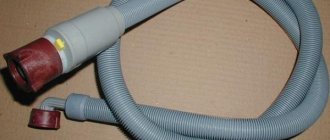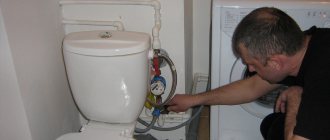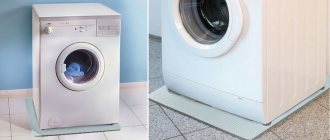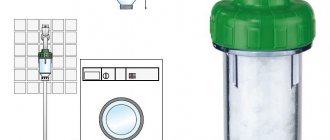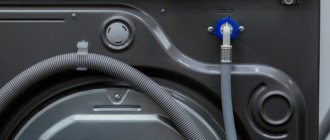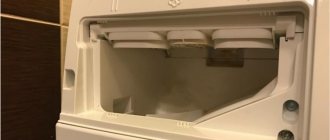Moscow, 04.03.2022, 04:11:43, editorial office of FTimes.ru, author Andrey Andreev.
It is worth paying special attention to the safe use of a washing machine in order to prevent various troubles, for example, from flooding your neighbors. Many people turn off cold and hot water taps during their long absence from home. Thus, when going on vacation or to the country, you don’t have to worry about something happening.
Experts also recommend turning off the water tap between uses of the washing machine. Many people wonder if this is enough to protect themselves from a flood caused by improper use of technology.
Why do you need to turn off the tap?
The inlet valve, which in a washing machine is responsible for supplying water and stopping it, can quickly wear out, so experts recommend turning off the water supply tap after each wash. The rapid failure of the valve is influenced by the fact that it is constantly under high pressure.
Some experts believe that most often the valve breaks at night, and due to the fact that the owners do not detect this in time, a flood occurs among the neighbors. It is also worth noting that manufacturers of washing machines are not responsible for the faulty condition of the valve if the water was not turned off when it broke. Therefore, it is so important to turn off the water supply in time.
Caring for the heating element and the internal cavities of the drum
burnt and whole heating elements
No, you don’t need to disassemble and clean anything, and it won’t work. It is enough to clean the machine once every three months with citric acid. The technology is incredibly simple: pour 50 - 70 grams of powder into the powder tray. the above-mentioned substance and run the machine without laundry in the washing mode at the highest temperature. This simple manipulation will avoid the formation of deposits on the inner surface of the drum and heating element.
If the water is very hard, then I recommend carrying out a professional cleaning procedure once every six months using “heavy artillery” - special reagents. Their effectiveness is such that after cleaning, the surface of a heating element that has been in operation for several years cannot be distinguished from a new one.
To turn off or not to turn off the washing machine tap
There are experts who do not recommend turning off the washing machine tap so often. Oleg Dranitsky, head of the household appliance certification body Testbet, said that frequent opening and closing of the tap can lead to its breakdown, which can also result in a flood. The expert recommends installing high-quality plumbing in your apartment, which will not give you any reason to think about a possible breakdown.
The specialist emphasized that modern equipment has a system called “aquastop”. Having installed it correctly, in case of damage to the hose or leakage, the water will be automatically turned off. This will save you from various problems, including no floods.
When the aquastop system starts working, it activates the inlet hose with solenoid valves. They are responsible for shutting off the water supply to the washing machine. The hose itself is connected to the water pipe. This allows the inlet hose in a protective sheath to withstand strong water pressure, which is 7 times higher than the permissible pressure in the water supply.
In addition, the “aquastop” system includes a tray with a float, as well as a microswitch, which is located in the base of the equipment itself. If something happens, this system automatically shuts off the water supply, and you don’t have to worry about floods.
Subject:
- Lifehacks
- Adviсe
Aquastop - salvation from flooding
What is the Aquastop system in a washing machine? This is a special additional hose that is already built into the washing machine. Unlike a conventional water supply, which can withstand 10 bar, it can withstand up to 70. In addition, the system is equipped with a special solenoid valve, which instantly shuts off the water supply to the machine in the event of a leak. Moreover, Aquastop works even during washing, so you don’t have to urgently try to turn off the water supply tap to the washing machine, the valve will do it for you.
How it works? A machine with the Aquastop system also has a special tray located deep inside. When water accumulates there, a sensor is triggered, which gives the valve a signal to stop pumping water.
In addition, Aquastop can stop the water supply even if you overdo it with detergent. But why? The fact is that when the product comes into contact with water, foam forms. And in large quantities it will overfill the tank and begin to quickly come out, risking damage to the electronics.
However, you should not constantly rely on Aquastop. After all, any system has costs and can misfire. It is better to follow all recommendations for operating the machine. To the question “to turn off the tap or not to turn off”, the answer is obvious. As you can see, you shouldn’t overdo it with detergents either, it can end badly for your car. Yes, there are times when hoses break for no apparent reason due to a manufacturing defect or something else. But you can only claim a guarantee if you have followed all the rules for shutting off the water.
Interesting:
- Do I need to turn off the water in my dishwasher?
- Repairing the water supply valve in a washing machine
- Bosch dishwasher valves
- The washing machine keeps filling with water
- Selecting and installing a tee tap for a washing machine
- The faucet light on the dishwasher is on.
Reader comments
- Share your opinion - leave a comment
WASHING MACHINE DOOR
In order for your iron assistant to serve you faithfully for a long time, you need to provide it with proper care. The main causes of breakdowns are the formation of scale on the electric heater and clogged filter.
However, the condition of the drum itself also plays an important role. Regular ventilation helps to avoid unpleasant odors and mold on the drum and rubber seals. To do this, leave the door ajar for at least one hour after each wash.
In addition, you should wipe all the internal parts of the machine with a dry cloth, especially pay attention to the rubber hatch, in the folds of which heavy dirt often accumulates.
who will answer? Do I need to close the tap after? washing.
#1 Ogonyok
Hello. We have an automatic machine. And like all automatic machines, they are connected to cold water; there is a tap on the pipe or hose. So I wanted to ask knowledgeable people, better than craftsmen, whether it is necessary to close this tap after washing. I heard that it is necessary, because some pressure can push through the rubber band and the tap needs to be changed. Others say that there is no need, that there is nothing pressing there. Please tell me, this is a very important question, since relatives are putting pressure on me to close it, but my husband says it’s not necessary, which is why there are quarrels.
Post edited by Ogonyok: May 24, 2010 - 12:43
#2 Guest_Alx._*
You don't have to close it.
#3 JAKI
I personally always close the tap.
#4 Kira
I turn off the tap, but sometimes I forget, but nothing breaks. for now
#5 2013tattoo
We live on the first floor, the tap has not been turned off even once in two years of use - it hasn’t broken.
#6 Beemer
For 7 years, the tap was closed only in case of moving or cleaning the filter mesh in the hose.
#7 pasha-as
The passport of the washing machine says that the tap is called an emergency tap and you only need to close it if you are moving or for maintenance work. I usually advise clients to close it only if they are leaving somewhere. The valve can withstand pressure up to 5 atmospheres. If you doubt it, I bet you will come to the workshop and load a couple of valves. And the tap must be turned at least once every two months so that it does not rust.
#8 [email protected]
in 7 years it closed once. and nothing, everything works, they found something to quarrel about. and let relatives close their houses if they want to
#9 Vasya Lysyi
In the water supply system (cold water), the pressure rarely rises to 2.5 atmospheres. There is no need to “use” the faucet without unnecessary need (once every two to three months). According to the “probability theory”, “catastrophe theory” and Murphy’s law, the more often you “use” the faucet, the sooner it will fail (especially “economy” class faucets from China). The washing machine has a reliable electric valve, it will handle it. True, I recommend closing the hot water tap at the inlet to the washing machine, an automatic machine made in Korea or Japan, which does not have a water heater, with a vertical drum arrangement and top loading. There are cases of breakage (due to pressure surges in the hot water supply system during test checks and preventive maintenance) of the supply, flexible hose, and the breakdown of the plastic nut at the point of connection to the heating plant system.
Post edited by Vasya Lysyi: May 24, 2010 - 19:15
#10 CAN man
If the faucet is Chinese, then it will quickly break and you will have to change it (it will start to drip). There is also a point that you can forget to open when you start washing, after steaming. Although it would be better to close it, it’s not a reason for quarrels P.S. We haven’t closed our house for 5 years (Chinese faucet)
Is it necessary to turn off the cold water supply tap to the washing machine after each wash?
If you don’t block it, in general, what are the consequences (what are the consequences), what do the instructions say?
Washing machine manufacturers' instructions always include a clause requiring that the water supply to the machine be turned off from the water supply system while the machine is not in use. There are two reasons for this indication:
- The hose through which water enters the machine is not designed for constant water pressure and there is always a risk that the slightest increase in water pressure (increase in pressure) will lead to a breakthrough in the hose.
- The water supply system to the washing machine includes a shut-off valve. It comes in different designs, but it always has a locking spring and a rubber gasket. Constant water pressure can lead to stretching of the spring, which, in turn, will lead to a violation of the tightness of the membrane, which is the main component of the shut-off valve. Also, under prolonged water pressure, the gasket may become unusable (burst).
I attach a photo of various models of shut-off valve installed in a washing machine
To be honest, I have not read the instructions on this matter, nor have I seen them, but from personal experience I can say that after each wash it is necessary to turn off the water , especially if you are not at home.
The neighbor above us flooded us with water three times because he did not close the tap in the bathroom - the pressure jumped a little, the hose going to the washing machine breaks, and flooding of the neighbors is guaranteed.
In addition, it is not for nothing that an additional tap is installed specifically for the washing machine. So you need to use it! Otherwise, there is a risk of flooding of the lower floors and the ensuing problems (payment for repairs, litigation, etc.).
The instructions for almost all washing machines clearly state that you need to close the tap.
Moreover, the manufacturer completely declines responsibility for valve failure if the tap is not turned off.
I mean problems with the valve that “holds” all the pressure on itself.
The valve is not designed for long-term and permanent operation, but only for temporary operation.
From practice I can add the following:
There have been cases when a washing machine, from its “birthday” until the end of its operation, worked without turning off the water supply tap after each wash, and it happened that after half a year the valve failed and, as a result, the apartments below were flooded.
I would advise everyone who lives above the first floor to simply get into the habit of constantly turning off the tap; as a rule, “trouble” happens either at night when the pressure in the system is higher (people do not use water), or in your absence.
I understand that it may be in an inconvenient place (behind the car, in a closet, etc.), redo it and don’t take risks, it may look like this correctly,
The faucet for the washing machine simply must be installed in an accessible place.
Source
The final stage of installation
When the water is supplied and the correct drainage has been carried out, make sure that the actions are correct. Connecting the washing machine yourself and providing the conditions for its operation is a labor-intensive task, but doable if all the nuances are followed. One of them is choosing the right position.
To prevent the washing machine from vibrating during washing and spinning, we connect it and install it vertically, adjusting the position of the body using the legs. For this purpose, a construction standard is used.
It is placed on the lid and the height of the legs is measured, with the level bubble located in the center. The measure is laid parallel to the front side, gradually making a shift towards the back wall. The process is repeated with the level positioned on the sides of the body.
Why disconnect the SMA from the water supply: preparatory work
An automatic washing machine (AWA) is a piece of equipment that is installed for a long time and is rarely moved to another place. But there are still situations when you need to disconnect the washing machine from the communications. For example:
- You have started renovations in the premises.
- You buy new equipment.
- Are you planning to move?
- You will be carrying out repairs or cleaning of the unit.
If you decide to do the work yourself, prepare the necessary tools. They may vary depending on the type of fasteners and the material of the components.
Important! Plastic nuts are unscrewed by hand because they are a fragile material and tools can damage the mount.
For metal connections, prepare:
- pliers;
- wrench;
- slotted and Phillips screwdrivers.
If the fastener is stuck to the base, spray it with WD-40.
So, the tools are prepared, let's move on to the next stage.
Do I need to turn off the water supply tap to the washing machine when it is not working?
Moscow, 10/23/2021, 08:04:12, FTimes.ru editorial office, author Andrey Andreev.
It is worth paying special attention to the safe use of a washing machine in order to prevent various troubles, for example, from flooding your neighbors. Many people turn off cold and hot water taps during their long absence from home. Thus, when going on vacation or to the country, you don’t have to worry about something happening.
Experts also recommend turning off the water tap between uses of the washing machine. Many people wonder if this is enough to protect themselves from a flood caused by improper use of technology.
Removing the shipping bolts
Before performing the main work, the transportation bolts are removed - fasteners that ensure the safe movement of washing equipment to its destination. Their main function is to protect the equipment tank from damage during transportation.
In standard models there are only four of them. They are located at the back at an equidistant distance from each other.
To remove the fasteners you will need a wrench for unscrewing 10, 14 mm nuts and pliers. Each bolt has a pin. He comes out first. Afterwards, pliers are used to remove the entire bolt using the tack-and-turn method. These steps will help you quickly remove the shipping bolts. The remaining holes are plugged with plastic plugs.
WHAT TO DO?
To ensure that your washing machine serves you for a long time and does not cause a flood, follow the following recommendations. After each wash, leave the door completely open for a couple of hours. At the same time, close the shut-off valve immediately after washing.
Install a non-return (anti-siphon) valve. This simple device is designed to protect the drain system from returning wastewater from the sewer back to the drum of the washing machine. Even if you are confident in your machine, close the washer door tightly just in case. At least when you leave home for a long time.
Where to route the drain hose
Connecting the washing machine drain hose through a siphon or directly to the general drain system is a reliable way to organize drainage. This way, water leakage is minimized if the hose is accidentally touched.
The option is aesthetically acceptable, since it becomes possible to hide communications elements behind a typewriter or other interior elements. The outlet of the washing machine hose into the sewer is connected to the sewer system.
